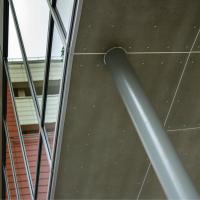Fire-resistant applications
Use
Fire-resistant applications
CETRIS® cement bonded particleboards is classified as class A2 in terms of flame reaction, with additional classification s1 (smoke generation while burning) and d0 (flaming particles), with overall classification A2-s1,d0, non-flammable material. Thanks to this property CETRIS® boards may be used for fire protection of building structures and direct building of structures with the prescribed fire resistance. Fire resistance concerns a specific and decisive property of building structures. It is expressed in time (in minutes) and it inicates the time for which the assessed structures are able to resist the effects of "standard fire", i.e. fire occurring under precisely defined conditions. The fire resistance classification is carried out either based on a test, including conditions of direct application, or based on extended application (calculations, extrapolation, etc.) by an authorized person who issues a fire classification certificate. Fire resistance is defined in minutes according to the basic scale of resistance for 15, 30, 45, 60, 90, 120 and 180 minutes. The values of fire resistance of the individual marginal conditions are identified as follows:
- R load-bearing capacity and stability
- E integrity
- I insulation ability – limit temperature on non-warmed surface
- W limit density of heat flow from non-heated side
- S combustible penetration
For every structure and pursuant to the respective project standard the determining marginal conditions are defined; then suitable structures are selected, such as:
- Structure complying with requirements of three basic marginal conditions, i.e. stability (R), integrity (E) and insulation ability (I) - the fire resistance of such structure is REI. These are primarily the requirements imposed on bearing fire separating structures, i.e. walls and ceilings.
- For non-bearing fire separating structures (interior partitions, soffits) fire resistance requirements need to meet only 2 marginal conditions, i.e. integrity (E) and insulation ability (I), thus EI.
- For bearing bar elements (beams and columns) only load capacity and stability are required - R.
|
|
Download information |
How to choose the right board: | Interactive guide |
